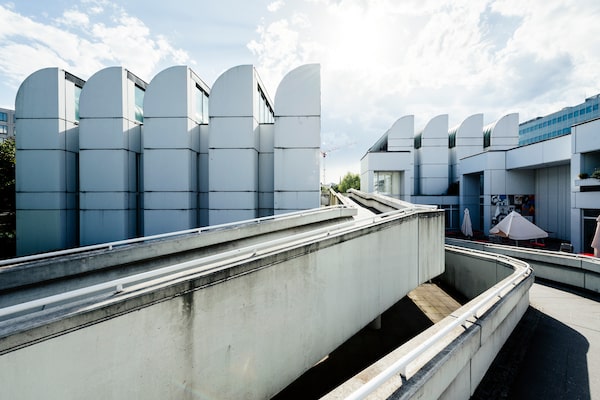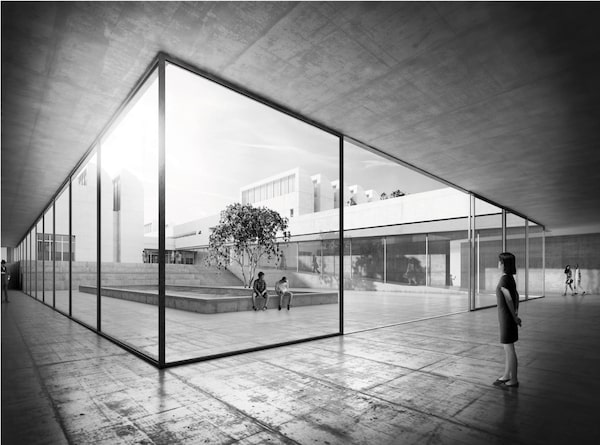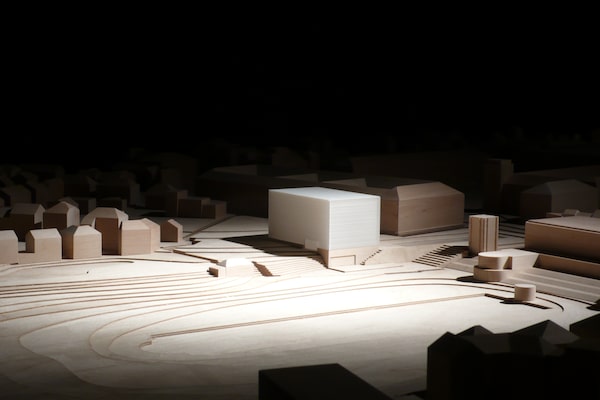
Today, the trailblazing school of modernist art, design and architecture's legacy can be found everywhere from skyscrapers to the layout of your iPhone screen.Handout
Atop a contemporary carpet of multicoloured squares and triangles sat chic and angular yellow-upholstered armchairs and a sleek Scandinavian-style desk. The only thing that seemed shockingly out of place was a heavy black vintage telephone, like something in a museum. It was the sole object in the office of the first Bauhaus University director, Walter Gropius, that looked its age – 100 years old this past April.
That’s when the trailblazing school of modernist art, design and architecture was born, in 1919 in the cultural German city of Weimar, a popular haunt of influential names such as Goethe, Schiller, Bach, Nietzsche and Liszt.
The Bauhaus Centenary is being celebrated with great fanfare and a roll call of events in the three German cities that were the school’s home between 1919 and 1933: Weimar, Dessau and Berlin. Though it only operated for 14 years, the movement spawned modernism and its concepts and philosophy spread around the globe. Today, Bauhaus legacy is everywhere, from skyscrapers, prefabricated buildings, flat-roofed houses and skylights to IKEA’s visually pleasing and functional products and the layout of your iPhone screen.

The Bauhaus-Archiv/Museum for Design in Berlin.Tillmann Franzen/Handout
A long-time fan, I headed to Germany for a week-long Bauhaus binge starting in Weimar, a charming city chosen, after the First World War, as Germany’s first democratic capital. Though the country was bankrupt at that time, creativity and hope were booming. Germany was ripe for change.
Walking the genteel, tree-lined cobblestone streets of Weimar, I poked around the original main Bauhaus University building, the centre of the current campus. Back in 1919 it was a cauldron of creativity and experimentation focused on minimalism and functionality where frilly, decorative Old World styles were banished. It was such a radical concept that 25 per cent of its students – women and men – came from around the world, a gathering of often offbeat characters brought together by funky clothing, holistic beliefs, crazy parties and unconventional ideas. It was the 1960s of the early 20th century and the conservative local population was not amused; mothers would threaten disobedient children, “If you don’t behave, I’ll send you to Bauhaus!”
This April, the first of three new German Bauhaus museums opened in Weimar. Adolf Hitler hated all things modern, so it was significant that the Bauhaus-Museum Weimar – a strong, confident white cube – was strategically placed alongside the massive Nazi Gauforum complex. Inside is a dizzying display of Bauhaus icons from Marcel Breuer’s steel tube Wassily Chair to Marianne Brandt’s forever contemporary tea infuser and videos of Oskar Schlemmer’s fantastical 1922 Triadic Ballet. Bauhaus students worked on weaving, ceramics, metalwork, art, music, dance, photography, furniture, architecture and even typography. “It was a completely new time, the dawn of a new life,” my Bauhaus researcher guide, Jayne Obst, said.

Bauhaus students' exploits went beyond architecture, furniture design and typography to include visual art, dance and music, research guide Jayne Obst says.Markus Hawlik/Handout
We walked through idyllic parkland past Goethe’s summer residence to the simple white Haus am Horn, a stylish, functional one-storey model home that was part of the 1923 Bauhaus Exhibition, designed to show off the school’s works to a population and state government increasingly displeased with their tax dollars funding this offbeat enterprise. Though word of Bauhaus got out internationally, funding was cut and the school shut down the following year.
Fortunately, the industrial city of Dessau, a two-hour drive northeast, invited and funded the new Bauhaus School from 1925 and that’s where it blossomed.
I took my time reaching Dessau, however, puttering by car around the rolling countryside, through quaint villages in search of Bauhaus treasures. In the lovely city of Jena, 23 kilometres away, I visited two Gropius villas and was lucky to experience a private tour of the spectacularly restored 1924 private Bauhaus residence called Haus Auerbach with its owner, Dr. Barbara Happe.

Staab Architekten’s design for a glass tower and entrance to the underlying museum won first prize at the Bauhaus-Archiv’s architecture competition.Handout
Fifty minutes away, in the old city of Erfurt, I lingered over an insightful exhibition at the Angermuseum called “4 Bauhausmadels” – 4 Bauhaus Gals – showcasing four creative Bauhaus female students and their life stories in a time when women’s freedom was just opening up.
Halle, the birthplace of Baroque composer George Frederick Handel, 120 kilometres north of Erfurt, knocked me out with its diverse Bauhaus offerings: the Grossgarage, an astonishingly progressive four-story glass-roofed 150-auto garage with a car lift from 1929; a modernist industrial water tower; and the colourful, hexagonal Sacred Trinity Church.
Finally, I made it to Dessau. It was here the school shifted its philosophy from combining art and craftsmanship to art and industry. This alienated many of its founding members, but propelled the school into the future. The city was desperate for better housing than just slums for the workers who flocked to booming factories. And they needed it quickly.

Bauhaus was such a radical concept that 25 per cent of its students – women and men – came from around the world, a gathering of often offbeat characters brought together by funky clothing, holistic beliefs, crazy parties and unconventional ideas.Handout
I strolled through the tranquil Gropius-designed housing complex of Torten Estate, rows of low-rise, modular, two-storey, flat-roofed townhouses still occupied today. Though each residence was small and simple, it had unheard-of 1920s luxuries such as indoor hot water plumbing and central heating. Similar to most Bauhaus buildings I’d visited throughout these former East Germany cities, this workers’ housing complex is part of the widespread Bauhaus UNESCO World Heritage Site.
Dessau’s shining star, however, is Gropius’s stunning 1926 Bauhaus Building with its trademark steel grids and massive glass curtain wall. It was one of the few buildings to survive the Second World War bombing that destroyed 80 per cent of the city; a city-wide installation, Invisible Places, fills in blanks where other Bauhaus buildings once stood.
Restored, the campus of the Bauhaus school is now a research and teaching institution dedicated to furthering Bauhaus ideas. The interior is a remarkable experience of light shifting through huge windows, clean lines, lean touches of signature red, yellow and blue colours, and railings crafted from water and gas pipes. For Bauhaus geeks, it’s a dream to overnight in the bright, simple students’ quarters and to dine in the minimalist canteen.

Professors Heike Hanada and Benedict Tonon collaborated on this model for the Bauhaus Museum in Weimar.Handout
After Dessau, I had one more pilgrimage to make: Berlin.
By 1932, with rising political turmoil and the 1929 financial crisis, Dessau’s Bauhaus School was closed and moved to Berlin, where German-American architect Mies van der Rohe became its third and final director. But within a year Hitler shut it down permanently, claiming the movement was infiltrated with Jews and Communists.
In 1938, New York’s Museum of Modern Art cemented Bauhaus influence with a major exhibition. Ironically, the Nazi’s persecution sped up the international spread of its ideas since many of its instructors and most promising students fled Germany: Gropius to Harvard’s Graduate School of Design; Laszlo Moholy-Nagy to found the Chicago Institute of Design; and van der Rohe, a celebrated Chicago architect, went on to design Canada’s two most famous Bauhaus icons – the Toronto-Dominion Centre and Montreal’s Westmount Square.

A rendering of architects Gonzalez Hinz Zabala's winning design for the Bauhaus Museum in Dessau.Handout
I started my final lap of Bauhaus immersion in the Hansaviertel, where a 1953 architectural competition brought talent from 13 countries to create a diverse showcase of modernist high-rises to fill the Second World War-bombed open spaces of West Berlin, chic and spacious retro buildings still sought after today as residences.
Lastly was Gropius’s last major project, the 1960 Berlin Bauhaus Archives. Since the unusual building is currently being updated and the complex expanded to re-open with Germany’s biggest Bauhaus collection in 2022, I wrapped my trip up at the temporary archives nearby, checking out the centenary exhibition. And I picked up a souvenir in the wonderful Bauhaus Shop: a classic white teapot so I can remain steeped in modernism back home.
The writer was a guest of the German National Tourism Board. It did not review or approve this article.

Bauhaus 100 events are taking place in three German cities: Weimar, Dessau and Berlin.Handout
Experiencing Bauhaus 100
Weimar
Bauhaus Walking Tour: Current or former students of Weimar’s Bauhaus University offer walking tours of various lengths including the original campus and the Haus am Horn. There is also an unguided audio-walk, “Where is Walter.”
Dessau
Bauhaus Dessau Foundation: The foundation offers numerous guided daily tours of the Bauhaus Building, the nearby Masters’ Houses and the Torten Estate workers’ housing project. A year-long program of celebrations includes the opening of the new Dessau Bauhaus Museum on Sept. 8, 2019.
Overnighting in the Bauhaus Studio Building: Stay in the Studio Building that once housed junior masters and promising students for about $60 to $100 a night. For authenticity there is no WiFi and only a communal bathroom on each hall. And then dine in the Bauhaus Canteen.
Berlin
Bauhaus in Berlin: The city is celebrating the centenary with many exhibitions and events. You can see the original building that is being reconstructed and expanded at Klingelhöferstraße 14, or visit the temporary archive exhibit/shop at Knesebeckstrasse 1-2 10623 Berlin.
Art:Berlin offers 2-hour English language Berlin Bauhaus tours from $27 per person.
For more information about the entire Bauhaus Centenary Program visit www.bauhaus100.com.
Live your best. We have a daily Life & Arts newsletter, providing you with our latest stories on health, travel, food and culture. Sign up today.